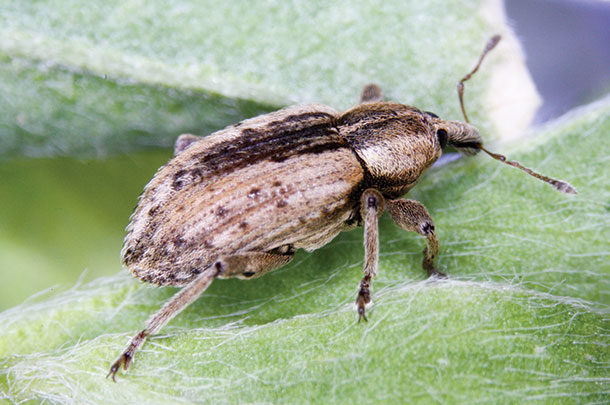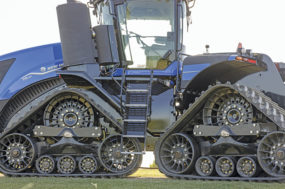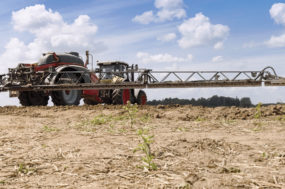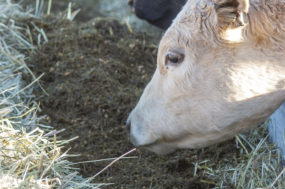Research has shown alfalfa weevils not only reduce the yield and quality of the first cutting, but also negatively impact subsequent plantings.
Economic threshold for weevils is based on the value of the harvested alfalfa and plant height at the time of larval weevil attack. Several universities, especially Iowa State and California State University, publish methods and guides for determining economic thresholds. In general, an economic threshold is 1.5 to 2 larvae per stem or 20 larvae in a sweep.
While conventional farmers have a number of chemical pesticides available to them, organic alfalfa producers must rely on cultural controls (rotation or early harvesting) and biological agents. A recently commercialized microbial may serve as a new biological tool to help manage this insect.
In the 1950s, USDA conducted a large-scale biocontrol program of the weevil in the Northeastern U.S., releasing seven species of parasitic wasps collected from Europe. Between these parasitoids and a naturally occurring fungus, insecticide use for the weevil was greatly reduced.
During the 1980s, the USDA released a number of parasitoid wasp species, collected from sites where they had become established farther east, across Northern Plains states. Some of these wasps, which originated from Eurasia, attack and kill the larval stage, while others attack, sterilize and ultimately kill the adult stage.
Surveys done by the USDA-ARS lab in Sidney, Montana, during the past decade found that two parasitoid wasps that attack larvae (Bathyplectes curculionis and Oomyzus incertus) have established in Montana and North Dakota and often kill more than half the weevil larvae in a field.
Thus, they are likely playing an important role in helping keep numbers low over many years and over several locations. B. curculionis has also been reported from Wyoming and Colorado.
In contrast, a collaborative four-state survey across Montana, North Dakota, Wyoming and South Dakota revealed that parasitoids attacking weevil adults are absent from the region.
One species in particular, Microctonus aethiopoides, is considered one of the most effective agents in other areas of the U.S. and is well established in Minnesota. USDA researchers in Sidney, Montana are evaluating the feasibility of reintroducing this parasitoid from the Great Lakes to complement the existing larval parasitoids which have already established in the Northern Plains.
In the Eastern U.S. and Canada, a fungus, Erynia phytonomi, naturally attacks larval weevils, on occasion reaching epizootic levels and suppressing populations. In the Northern Plains alfalfa, this fungus seems scarce based on USDA-ARS surveys during the past 10 years. Another fungus, Beauveria bassiana, has been seen attacking adults, but it is generally rare.
Recently, Montana State University in Conrad, Montana, evaluated an organically certified, commercial beauveria product alone and coupled with azadirachtin (neem) or pyrethroid, in comparison to a commercial spinosad, using laboratory assays.
The beauveria had modest efficacy with the neem and pyrethroid-synergizing efficacy, but all were quite inferior to the spinosad and took four to five days to exert full efficacy. Field evaluations have not yet occurred.
Recently, a new beetle-active Bacillus thuringiensis (Bt*) has been commercialized for use against a number of beetles, including the alfalfa weevil. Most commercial coleopteran Bts have a beetle-specific CRY3 family protein. This new Bt, B. thuringiensis galleriae strain SDS-502, has a novel toxic protein, CRY8Da.
It targets a number of scarab and other beetles, including the alfalfa weevil. The Bt must be eaten by the larvae to be effective, so thorough foliar spray coverage, targeting the locations of the larvae, is essential.
A spreader-sticker, one of several Organic Materials Review Institute (OMRI) certified for organic use, may also be necessary. The Bt product is compliant with the USDA National Organic Program.
In a 2014 trial by University of California – Davis, the Bt gave 70 percent reduction of larval numbers. Field tests by USDA-ARS in Sidney, Montana, and Montana State University in 2016 – with applications at high and low labeled rates – gave 11 to 60 percent reduction of larval populations depending on the rate.
We did target late second-instar larvae with one spray only, so two sequential sprays beginning with the first instar larvae may be more effective.
Our hopes that a partial reduction of larval populations by the Bt would increase the efficiency of attack by the pupal parasitoids on the survivors were not fulfilled in our tests, however. Parasitism rates among the survivors seemed to be unaffected in comparison to no-Bt controls. Additional testing is planned.
Nevertheless, the Bt is not a sole solution but should be part of an integrated pest management (IPM) program. The University of California IPM Program and ATTRA Sustainable Agriculture Program publish extensive agronomic guides for both conventional and organic alfalfa.
The USDA lab is also exploring habitat and landscape management approaches. Certainly, strip harvesting alfalfa allows the weevil predators and parasitoids to better survive a cutting and impact subsequent weevil generations.
Researchers at the USDA-ARS lab in Montana have found that larger fields have higher alfalfa weevil numbers on average and are more likely to sustain economic infestations of weevils than smaller fields. Similar results have been found by researchers at University of Wyoming, suggesting this is a common pattern.
At the same time, more alfalfa acreage in the landscapes surrounding individual fields was linked with both increased stability in attack by biocontrol wasps and reduced pest densities and outbreak duration.
Thus, planting smaller, individual fields that are more evenly spread across the landscape is predicted to reduce weevil impacts and maximize the potential efficacy of the established biological control agents. ![]()
PHOTO: Effective alfalfa weevil control takes more than one approach, which might include predatory wasps, pesticides and targeted fungus. Research leads us further with a new product approved for organic production. Photo by Erik J. Wenninger, University of Idaho.
Tatyana Rand is with USDA-ARS in Sidney, Montana. Gadi V.P. Reddy is with Montana State University in Conrad, Montana.
* Mention of trade names or commercial products in this publication is solely for the purpose of providing specific information and does not imply recommendation or endorsement by the U.S. Department of Agriculture.
Stefan Jaronski is with USDA-ARS in Sidney, Montana. Email Stefan Jaronski.









